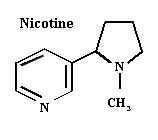Chantix (varenicline tartrate) For Smoking Cessation
Both the New York Times (link)
and the Washington Post (link)
carried an article about the new smoking-cessation pill from Pfizer.
The brand name for the product is Chantix;
the generic name is varenicline tartrate.
Varenicline tartrate was the Prous Scientific Molecule of the Month for March 2006.

Chantix (varenicline tartrate)

Chantix is a partial agonist for a particular type of nicotine receptor. The term partial agonist refers to a chemical that activates the receptor, but is not able activate the receptor to its full extent.
In the case of Chantix, it acts on a subtype of nicotine receptor called the α4β2 (alpha4beta2 nicotinic receptors). Chantix activates these receptors, providing an effect similar to that of a low to medium amount of nicotine. However, because it is a partial agonist, it is not possible to get as strong an effect as one would get with a high dose of nicotine. In fact, the presence of Chantix would make it impossible for the receptors to be activated fully, even in the presence of a high dose of nicotine.
As a result, the patient gets relief from nicotine craving, but only to a certain extent. Smoking a cigarette while taking Chantix would not result in increased activation of the receptors.
The behavioral theory here, is that it will be much easier to quit smoking, once the behavior of smoking is not coupled with a reward. That is, it is no longer positively reinforced.
Likewise, the negative reinforcement is eliminated. Once the behavior of smoking no longer results in a relief from craving, there is not so much of a reason to keep doing it.
Note that the mechanism of action of Chantix is analogous to that of Subutex and Suboxone (buprenorphine).
One of the reasons that addiction is such a nasty problem, is that the addictive behavior is reinforced both positively and negatively. Not only does the behavior lead to something positive, but it also avoids a negative consequence. In the case of addiction, the negative consequence is the withdrawal syndrome. See this e-Medicine page for on overview of the problem of nicotine addiction.
Of course, addiction is a complex phenomenon. Simple behavioral models are not perfect. It follows, then, that the results of the treatment are less than perfect. According to the Washington Post:
Another thing to keep in mind, when interpreting the success rate, is this: many people have already quit smoking. Presumably, the ones who continue to smoke are those who have the greatest difficulty in quitting. It is likely that most of the people who participated in the studies were people who already had tried to quit several times. Therefore, any improvement seen with the drug is all the more impressive.
Varenicline tartrate was the Prous Scientific Molecule of the Month for March 2006.

Chantix (varenicline tartrate)

Chantix is a partial agonist for a particular type of nicotine receptor. The term partial agonist refers to a chemical that activates the receptor, but is not able activate the receptor to its full extent.
In the case of Chantix, it acts on a subtype of nicotine receptor called the α4β2 (alpha4beta2 nicotinic receptors). Chantix activates these receptors, providing an effect similar to that of a low to medium amount of nicotine. However, because it is a partial agonist, it is not possible to get as strong an effect as one would get with a high dose of nicotine. In fact, the presence of Chantix would make it impossible for the receptors to be activated fully, even in the presence of a high dose of nicotine.
As a result, the patient gets relief from nicotine craving, but only to a certain extent. Smoking a cigarette while taking Chantix would not result in increased activation of the receptors.
The behavioral theory here, is that it will be much easier to quit smoking, once the behavior of smoking is not coupled with a reward. That is, it is no longer positively reinforced.
Likewise, the negative reinforcement is eliminated. Once the behavior of smoking no longer results in a relief from craving, there is not so much of a reason to keep doing it.
Note that the mechanism of action of Chantix is analogous to that of Subutex and Suboxone (buprenorphine).
One of the reasons that addiction is such a nasty problem, is that the addictive behavior is reinforced both positively and negatively. Not only does the behavior lead to something positive, but it also avoids a negative consequence. In the case of addiction, the negative consequence is the withdrawal syndrome. See this e-Medicine page for on overview of the problem of nicotine addiction.
Of course, addiction is a complex phenomenon. Simple behavioral models are not perfect. It follows, then, that the results of the treatment are less than perfect. According to the Washington Post:
Several studies conducted in Europe on about 2,000 smokers and presented in November at an American Heart Association conference showed that a year after initial treatment with varenicline, abstinence rates were 22 percent, versus 16 percent among those given Zyban. Just 8 percent of those given dummy medicines had stopped after a year.A success rate of 22% may not sound impressive. However, smoking is so prevalent and so damaging, that even a small success rate could have a large impact on public health.
Another thing to keep in mind, when interpreting the success rate, is this: many people have already quit smoking. Presumably, the ones who continue to smoke are those who have the greatest difficulty in quitting. It is likely that most of the people who participated in the studies were people who already had tried to quit several times. Therefore, any improvement seen with the drug is all the more impressive.

 :
Joseph j7uy5
:
Joseph j7uy5
<< Home